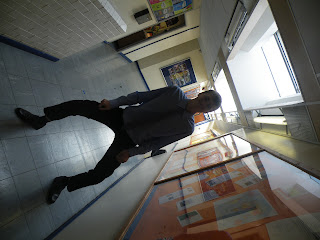Sunday, 30 September 2012
Mise-En-Scene
Mise-En-Scene is a french term which means 'Put on the scene'. This includes things such as costume and props.
Costumes:
For the costumes we decided to have the mafia boss wearing a black jumper, white shirt, black tie, black trousers and black shoes. For Chuck we decided he should wear a black shirt, black trousers and black shoes.
Props:
For props we decided to keep it simple by only using a table and two chairs and nothing more.
Costumes:
For the costumes we decided to have the mafia boss wearing a black jumper, white shirt, black tie, black trousers and black shoes. For Chuck we decided he should wear a black shirt, black trousers and black shoes.
Props:
For props we decided to keep it simple by only using a table and two chairs and nothing more.
Preliminary Task: Story Board & Script
Before we were alowed to start filming for our preliminary task we had to sort out a script and a story board. Below is an image of our finished story board.
Mafia boss: What do you think you're playing at Chuck?
Our Preliminary task envolves a mafia boss walking to a warehouse, walking up to a man who is sat at a table, the two men then exchange a few lines of dialouge. The Script for this is as follows:Mafia boss: What do you think you're playing at Chuck?
Chuck: What are you talking about?
Mafia boss: You know exactly what I'm talking about!
Chuck: I'm sorry, it won't happen again!
We have started filming for this but we have yet to finish it. We hope to finish filming within the next few lessons, or in spare time if we need to.
Preliminary Task: Cast & Crew
Twin Pine Films had a disscusion and we have come up with a cast and crew list which is as follows:
John Power- Chuck
George Hopkins- Mafia Boss
Mateusz Zbielski- camera man/ director
Jamie Oliver- lighting and props manager
John Power- Chuck
George Hopkins- Mafia Boss
Mateusz Zbielski- camera man/ director
Jamie Oliver- lighting and props manager
Basic Camera Shots
In this lesson we were asked to go out in our groups and get some pictures of the different camrea shots we had learned. Below are the pictures that Twin Pine Films captured...
 |
| Extreme Long Shot/ Establishing Shot (ELS) This shot is used to view the scenery only. |
Saturday, 29 September 2012
Basic Camera Movements
Below is a list of the different types of camera movements:
Tracking Shot: Moving inwards and outwards with the camera (NOT ZOOM!!!)
Crab Shot: Moving side to side with the camera.
Arc Shot: Circles around a character or object.
Crane Shot: Vertical View (from a crane)
Panning Shot: moves left and right but the camera stays still.
Tilt Shot: up and down movement on an axis.
Thursday, 20 September 2012
Preliminary Task
In this lesson we were told to get into groups and come up with a name for our film company. In my group we had myself, John Power, Jamie Oliver and Mateusz Zbielski. We had a group discussion about what to call ourselves, then we decided to call it "Twin Pine Films" after the shopping mall in "Back to the Future".
 |
| This is a picture of Twin Pine Films hard at work discussing what to do for our Preliminary Task. |
Wednesday, 19 September 2012
Foundation Portfolio
During AS Media we do two tasks, The Preliminary Exercise and the Main Task. Below are description of both tasks:
Preliminary Exercise
Continuity task involving filming and editing a character opening a door, crossing a room and sitting down in a chair opposite another character, with whom she/he then exchanges a couple of lines of dialogue. This task should demonstrate match on action, shot/reverse shot and the 180-degree rule.
Main Task
The titles and opening of a new teen horror film, to last a maximum of two minutes. All video and audio material must be original, produced by the candidates, with the exception of music or audio effects from a copyright-free source. Both preliminary and main tasks may be done individually or as a group. Maximum four members to a group.
Saturday, 8 September 2012
Subscribe to:
Comments (Atom)






